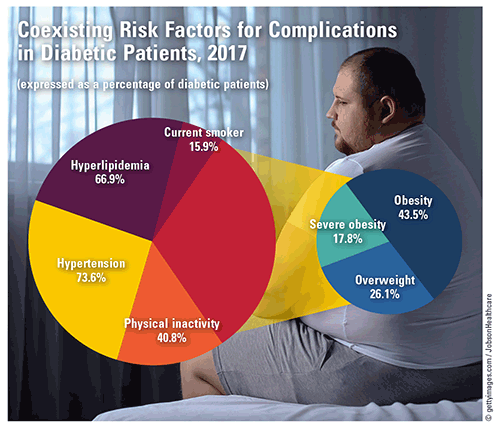US Pharm. 2019;44(10):15.
According to the CDC, 30.3 million people had diabetes and 84.1 million had prediabetes (9.4% and 26.1%, respectively, of the population) in 2015. Among diabetic patients, 90% to 95% of adults had type 2 diabetes (T2DM). Modifiable risk factors for complications of diabetes include overweight/obesity, poor diet, hypertension, smoking, and physical inactivity.

Preventive Programs: As of 2016, >1 million diabetic patients were enrolled in a diabetes self-management education and support program in order to improve quality of life and lower the risk of complications. The recently initiated Medicare Diabetes Prevention Program could benefit the 22 million individuals aged 65 years and older with prediabetes, 90% of whom are unaware of their prediabetic status. Participation in diabetes education has increased in diabetic patients (from 56.8% in 2008 to 58% in 2010), and the targeted participation rate of 62.5% may be reached by 2020.
Hyperlipidemia and Hypertension: Diabetes lowers HDL cholesterol and raises triglycerides and LDL cholesterol, doubling the risk of heart disease and stroke compared with nondiabetic persons. From 2005–2008 to 2009–2012, the proportion of diabetic patients whose LDL was controlled decreased 5.9% (from 53% to 49.9%). Lipid control can reduce the risk of cardiovascular (CV) complications by 20% to 50%. Nearly 74% of diabetic adults are hypertensive, and blood pressure >140/90 is linked to an increased risk of T2DM. From 2005–2008 to 2009–2012, the proportion of diabetic patients whose blood pressure was controlled increased 6.9% (from 51.8% to 55.4%). A 10-mmHg decrease in blood pressure can reduce the risk of diabetes complications by up to 12%.
Physical Inactivity: The duration of increased insulin sensitivity is generally a maximum of 72 hours, and the American Diabetes Association recommends that diabetic patients go no more than 2 days (consecutive) without aerobic exercise in order to improve glycemic control, support weight maintenance, and reduce risk of CV disease. The National Diabetes Prevention Program reported a 58% decrease in diabetes development in high-risk individuals who exercised for at least 150 minutes weekly. Diabetic persons were no more likely to exercise than nondiabetic persons, and 50% dropped out of supervised exercise programs (90% after 1 year). Those more likely to adhere to exercise programs were elderly persons, females, self-referred patients, and those participating in programs with a spouse. From 2005–2008 to 2011–2012, prediabetic patients increased their physical activity by 22.6% (from 44.6% to 54.7%), exceeding the 2020 target. People who achieved recommended levels of even moderate activity were about 30% less likely than inactive individuals to develop diabetes.
To comment on this article, contact rdavidson@uspharmacist.com.





